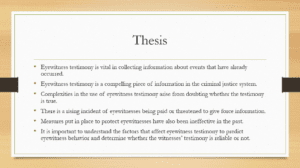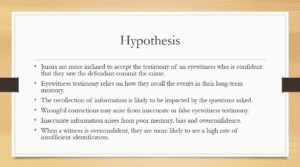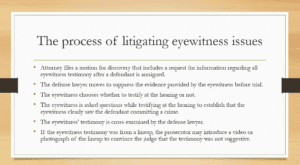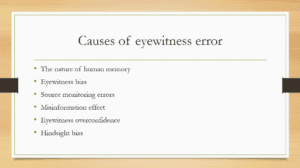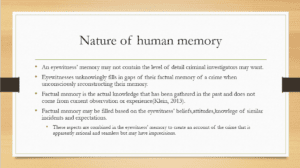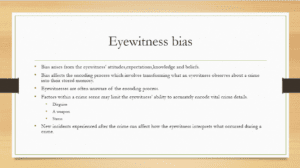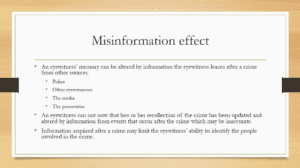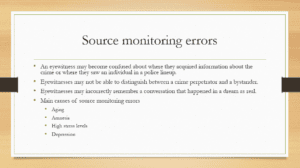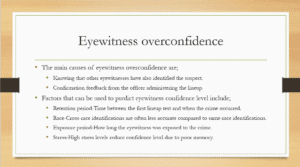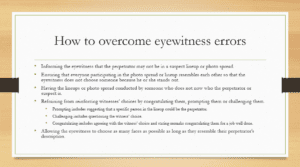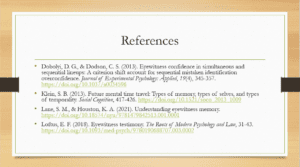Eyewitness Testimony
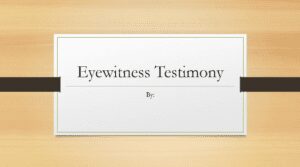
Eyewitness testimony is vital in collecting information about events that have already occurred, and it is considered a compelling piece of information in the criminal justice system. Complexities in the use of eyewitness testimony arise from doubting whether the testimony is true. The rising incidents of eyewitnesses being paid or threatened to give force information have significantly impacted eyewitness testimony in the criminal justice system. Measures put in place to protect eyewitnesses have also been ineffective, forcing eyewitnesses to provide false affidavits to defend themselves. Therefore, it is crucial to understand the factors that affect eyewitness testimony to predict eyewitness behavior and determine whether the eyewitness testimony is reliable or not.
Jurors are more inclined to accept the testimony of an eyewitness who is confident that they saw the defendant commit the crime. The testimony relies on how the eyewitness recalls the events in their long-term memory. The recollection of information is likely to be impacted by the questions asked. In most cases, wrongful convictions arise from inaccurate or false eyewitness testimony. Incorrect information stems from poor memory, bias, and overconfidence. When a witness is overconfident, they are likelier to see a high rate of insufficient identification.
Litigating eyewitness issues begins with the attorney filing a motion for discovery that includes a request for information regarding all eyewitness testimony after a defendant is prosecuted. The defense lawyer then moves to suppress the evidence provided by the eyewitness before trial. The eyewitness chooses whether to testify at the hearing or not. Suppose the eyewitness decides to testify at the hearing. In that case, he or she is asked questions while testifying to establish that the eyewitness saw the defendant committing a crime. The defense lawyer then cross-examines the eyewitness testimony. If the eyewitness testimony was from a lineup, the prosecutor might introduce a video or photograph of the lineup to convince the judge that the testimony was not suggestive.
The leading causes of eyewitness error are the nature of human memory, eyewitness bias, source monitoring errors, misinformation effect, eyewitness overconfidence, and hindsight bias.
An eyewitness’ memory may not contain the level of detail criminal investigators want. Eyewitnesses unknowingly fill gaps in their factual memory of a crime when unconsciously reconstructing it. According to Klein (2013), real memory is the knowledge gathered in the past and does not come from current observation or experience. It may be filled based on the eyeyewitness’eliefs’ beliefs, attitudes, knowledge of similar incidents, and expectations combined to create rational, seamless national, and seamless account imprecisions.
Bias arises from eyewitnesses’ attitudes, expectations, knowledge, and beliefs. It affects the encoding process, which involves transforming eyewitnesses’ observations about a crime into their stored memory. Eyewitnesses are often unaware of the encoding process and may not knowingly interfere with it (Loftus, 2018). Factors within a crime scene may limit the eyeyewitness’sbility to encode vital details accurately. The factors include disguise, a weapon, and stress levels. New incidents experienced after the crime can also affect how the eyewitness interprets what occurred during a crime.
An eyewitness’s memory can be altered by information the eyewitness learns after a crime from sources such as the police, other eyewitnesses, the media, and the prosecutor (Lane & Houston, 2021). An eyewitness cannot know that their recollection of the crime has been updated and altered by information from events after the crime, which may be inaccurate. Information acquired after a crime may limit the eyeyewitness’bility to identify the people involved.
An eyewitness may become confused about where they acquired information about the crime or where they saw an individual in a police lineup. They may also be unable to distinguish between a crime perpetrator and a bystander and may incorrectly remember a conversation that happened in a dream accurately. The leading causes of source monitoring errors are aging, amnesia, high-stress levels, and depression.
The leading causes of eyewitness overconfidence are knowing that other eyewitnesses have identified the suspect and confirmation feedback from the officer administering the lineup. Some factors that can predict eyewitness confidence levels include retention period, race, exposure period, and stress (Dobolyi & Dodson, 2013). The retention period is the time between the first lineup test and when the crime occurred, and the exposure period includes the time the eyewitness was exposed to the crime. Cross-race identifications are often less accurate compared to same-race designations. High-stress levels reduce confidence levels due to poor memory.
Hindsight bias includes selecting an individual from a police lineup because they closely resemble the person in their memory. The leading causes of relative judgments that create hindsight bias are logically assuming that law enforcement officers will not conduct a lineup if they do not have a suspect, pressure from relatives, law enforcement officers, and friends to identify the crime perpetrator, and eyeyewitness’ssumption that they will be viewed as a failure if they cannot remember the perpetrator from a police lineup. Simultaneous lineups increase the chances of hindsight bias because participants are presented simultaneously.
One of the measures that can be taken to overcome eyewitness errors is informing the eyewitness that the perpetrator may not be in a suspect lineup or photo spread. The second measure is ensuring that everyone participating in the photo spread or lineup resembles each other so that the eyewitness does not choose someone because they stand out. The third measure is having the lineups or photo spread conducted by someone who does not know the perpetrator or suspect. The fourth measure is refraining from reinforcing wiwitnesses’hoices’ voices by congratulating them, prompting them, or challenging them. Prompting includes suggesting that a specific person in the lineup could be the perpetrator. Challenging includes questioning the witness’hoice. Congratulating includes agreeing with the witness’ choice and stating remarks congratulating them for a job well done. The fifth measure allows the eyewitness to choose as many faces as possible as long as they resemble their peperpetrator’sescription.
Dobolyi, D. G., & Dodson, C. S. (2013). Eyewitness confidence in simultaneous and sequential lineups: A criterion shift account for sequential mistaken identification overconfidence. Journal of Experimental Psychology: Applied, 19(4), 345-357. https://doi.org/10.1037/a0034596
Klein, S. B. (2013). Future mental time travel: Types of memory, types of selves, and types of temporality. Social Cognition, 417-426. https://doi.org/10.1521/soco_2013_1009
Lane, S. M., & Houston, K. A. (2021). Understanding eyewitness memory. https://doi.org/10.18574/nyu/9781479842513.001.0001
Loftus, E. F. (2018). Eyewitness testimony. The Roots of Modern Psychology and Law, 31-43. https://doi.org/10.1093/med-psych/9780190688707.003.0002
ORDER A PLAGIARISM-FREE PAPER HERE
WeWe’llrite everything from scratch
Question

Eyewitness Testimony
Create an IP4 PowerPoint with the information you have developed in your IP3 paper.
Prepare and deliver a professional presentation based on the research paper you have worked on in all sessions. Your presentation must be a minimum of 10 PowerPoint slides, excluding the cover and reference slides (with presenter notes on each slide).
Your supervisor was impressed with your research and asked you to create a presentation to share what you learned with the department. There will be no oral presentation, so you must provide sufficient detail in the presenter’s presentation on each slide.

